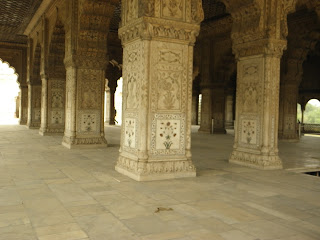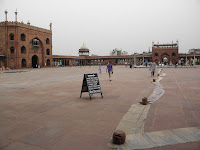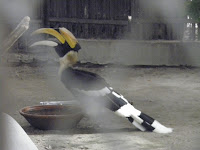
Here is the outer wall of the Red Fort, which is in the old(er) section of Delhi. As noted, you can see it from the Jama Masjid. Still a puzzle to me why historical remnants of forts and mosques seem so much more cheerful than the active mosques in New Delhi.
 Even on this hot day, over 100 F, you can see how crowded it is here. As I suspected, people do not stay indoors when it's hot. Life goes on, everyone has to go to work, and everyone still wants to have fun, which in New Delhi seems to require leaving the house, rather than staying in and watching TV.
Even on this hot day, over 100 F, you can see how crowded it is here. As I suspected, people do not stay indoors when it's hot. Life goes on, everyone has to go to work, and everyone still wants to have fun, which in New Delhi seems to require leaving the house, rather than staying in and watching TV. To the left is one of the entrances to the fort. and to the right is a kind of outdoor hallway lined with little shops, just as it was in the great days of the fort. The high arched ceiling was a wind tunnel that created a pleasant breeze.
People have been asking me if it was hazy like this the whole time. Well, I didn't notice the haze until we looked at the photos. It was dry (premonsoon) most of the time we were there.



 Even now I am enthralled with the delicacy of the stone art that one sees in Indo-Islamic architecture.
Even now I am enthralled with the delicacy of the stone art that one sees in Indo-Islamic architecture. I hope you take a closer look at the detail in these photos. Those little alabaster boxes we see in World Market or Earthbound or the like are just echoes of the fine detail that decorate Islamic monuments.
For instance, that would be semi-precious gem inlay on that fenced-in bench.
Here is another Indo-Islamic feature, Islamic arches of Indian red stone.
Doesn't this remind you of Greek architecture?

This
Another little mosque. I believe. This was quite a lovely fort. And another example of semi-precious gem inlay. On pillars for pete's sake. Even with remnants of the original fort, one gets a sense of the opulence of life for the Muslin rulers.



















































